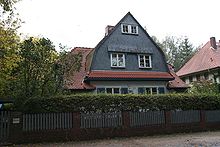Erbacher Strasse 138 to 150
| Complete system of workers' houses | |
|---|---|
 Workers House (2005) |
|
| Data | |
| place | Darmstadt |
| architect | Eugen Seibert , Georg Metzendorf , Arthur Wienkoop and Karl Hofmann |
| Construction year | around 1900 and 1908 |
| Coordinates | 49 ° 52 '19.3 " N , 8 ° 41' 5.1" E |
The entire system of workers' houses at Erbacher Strasse 138 to 150 are buildings in Darmstadt .
History and description
The entire workers' houses complex includes houses on the eastern edge of Darmstadt that are unique in terms of their architectural history.
Workers' houses at Erbacher Strasse 138, 140 and 142
In 1908 the workers' houses at Erbacher Strasse 138, 140 and 142 were built for an exhibition on Mathildenhöhe . As part of the major Hessian state exhibition for fine and applied arts, the organizers also designed an exhibition for “small apartment art ” with a total of six single-family and semi-detached houses.
The “model workers' houses” were designed by well-known architects such as Georg Metzendorf , Joseph Maria Olbrich , Heinrich Walbe and Arthur Wienkoop . These buildings were demolished after the exhibition ended. Three of these workers' houses were moved to Erbacher Strasse.
Workers' house at Erbacher Strasse 138
Worker's house number 138 was built according to plans by the planner Eugen Seibert .
Workers' house at Erbacher Strasse 140
Worker's house number 140 was built according to plans by the planner Georg Metzendorf.
Workers' house at Erbacher Strasse 142
The workers' house number 142 was built according to plans by the planner Arthur Wienkoop.
Worker semi-detached houses at Erbacher Strasse 144/146 and 148/150
The two semi-detached houses on the edge of the forest also belong to the overall complex. These houses were built around 1900 - as residential houses for the workers of the Grand Ducal Dairy - according to plans by the architect Karl Hofmann .
Monument protection
The entire complex of workers' houses is considered a cultural monument for architectural and city-historical reasons .
literature
- Günter Fries et al .: City of Darmstadt. ( Monument topography Federal Republic of Germany , cultural monuments in Hesse .) Vieweg Verlag , Braunschweig 1994, ISBN 3-528-06249-5 , p. 370 f.
